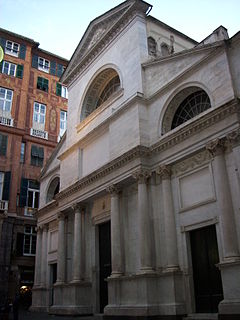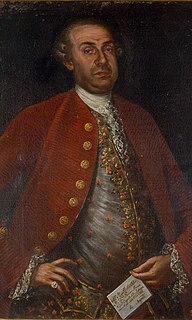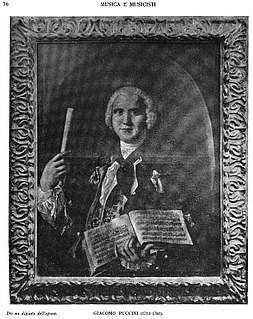Related Research Articles

Bernardo Pasquini was an Italian composer of operas, oratorios, cantatas and keyboard music. A renowned virtuoso keyboard player in his day, he was one of the most important Italian composers for harpsichord between Girolamo Frescobaldi and Domenico Scarlatti, having also made substantial contributions to the opera and oratorio.
Antonio Lotti was an Italian composer of the Baroque era.

Giacomo Antonio Perti was an Italian composer of the Baroque era. He was mainly active at Bologna, where he was Maestro di Cappella for sixty years. He was the teacher of Giuseppe Torelli and Giovanni Battista Martini.

Antonio Alessandro Boncompagno Stradella was an Italian composer of the middle Baroque period. He enjoyed a dazzling career as a freelance composer, writing on commission, and collaborating with distinguished poets, producing over three hundred works in a variety of genres.

Kyrie, a transliteration of Greek Κύριε, vocative case of Κύριος (Kyrios), is a common name of an important prayer of Christian liturgy, also called the Kyrie eleison.
Messa di Gloria is a nine movement mass, composed by Gioacchino Rossini for the Arciconfraternita di San Luigi. First performed on 24 March 1820 in the Chiesa di San Ferdinando in Naples, it is in the traditional form of a "Gloria" mass, that is a setting of the first two prayers of the Catholic mass, the Kyrie and Gloria. The Messa di Gloria was the only major piece of sacred music written while Rossini was still an active opera composer.
Giovanni Comisso was an important Italian writer of the twentieth century, appreciated by Eugenio Montale, Umberto Saba, Gianfranco Contini and many others.

Marco Benefial was an Italian, proto-Neoclassical painter, mainly active in Rome. Benefial is best known for his repudiation of 18th century decorative Rococo styles pre-eminent in the Rome dominated by Carlo Maratta pupils. His paintings portrayed tangible human figures, with complex treatment of space, and luminous, warm colors. Along with the altarpieces and frescoes, he also painted many portraits. Because he partnered with some inferior artists who subsequently received credit, some of his paintings have been frequently misidentified.

Antonio d'Enrico, called Tanzio da Varallo, or simply il Tanzio was an Italian painter of the late-Mannerist or early Baroque period.

Giacomo Boni was an Italian painter of the late-Baroque period, active mainly in Genoa.

Carlo Giuseppe Ratti (1737–1795) was an Italian art biographer and painter of the late-Baroque period. He was a pupil of the painter Giovanni Agostino Ratti. Born in Savona, he moved to Rome where he befriended Anton Raphael Mengs and Pompeo Batoni. He died in Genoa, where he labored for many years.

Carlo Francesco Pollarolo was an Italian composer, chiefly of operas. Born into a musical family, he became the cathedral organist of his home town of Brescia. In the 1680s he began composing operas for performance in nearby Venice. He wrote a total of 85 of them as well as 13 oratorios. His operatic style is noted for its development of arias accompanied by the orchestra and it shows some influence from the contemporary French opera of Jean-Baptiste Lully.

Benedetto Pamphili was an Italian cardinal, patron of the arts and librettist for many composers.

Santa Maria delle Vigne is a Roman Catholic basilica church in Genoa, Italy. It was built in the 10th century. The main altar was completed in 1730 by Giacomo Antonio Ponsonelli. The church is also the final resting place of the leading early Italian composer Alessandro Stradella, who was murdered in 1682.

Gennaro Manna was an Italian composer based in Naples. He was a member of the Neapolitan School. His compositional output includes 13 operas and more than 150 sacred works, including several oratorios.

Jacopo (Giacomo) Puccini was an 18th-century Italian composer who lived and worked primarily in Lucca, Tuscany. He was the first of five generations of composers, the most famous of whom was his great-great-grandson, the opera composer Giacomo Puccini.

Carlo Negrini was an Italian spinto tenor and creator of Gabriele Adorno in Verdi’s opera Simon Boccanegra.

Genoa is the capital of the Italian region of Liguria and the sixth-largest city in Italy. In 2015, 594,733 people lived within the city's administrative limits. As of the 2011 Italian census, the Province of Genoa, which in 2015 became the Metropolitan City of Genoa, had 855,834 resident persons. Over 1.5 million people live in the wider metropolitan area stretching along the Italian Riviera.

Prè is a neighbourhood in the old town of the Italian city of Genoa. It was one of the six sestieri of ancient Genoa. At present it is part of the Genoa's city I Municipio. Located close to the old harbour, it is likely the best-known neighbourhood of the old town of Genoa.
References
- ↑ Nuova rivista musicale italiana 1971 "Musiche inedite a Genova Con un concerto tenuto a Genova presso il Loggiato di Santa Maria di Castello il 19 dicembre ... nell'Oratorio di San Filippo Neri con l'esecuzione di musiche sacre di Carlo Sturla (Pastorale, Taedet animam, Kyrie 1° e 2°, Christe, Gloria, sempre nella revisione di Adelchi Amisano"